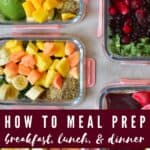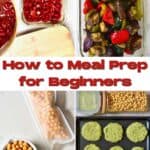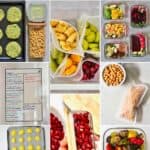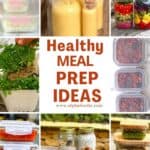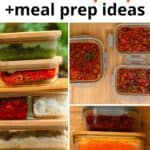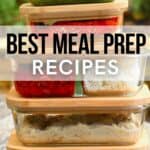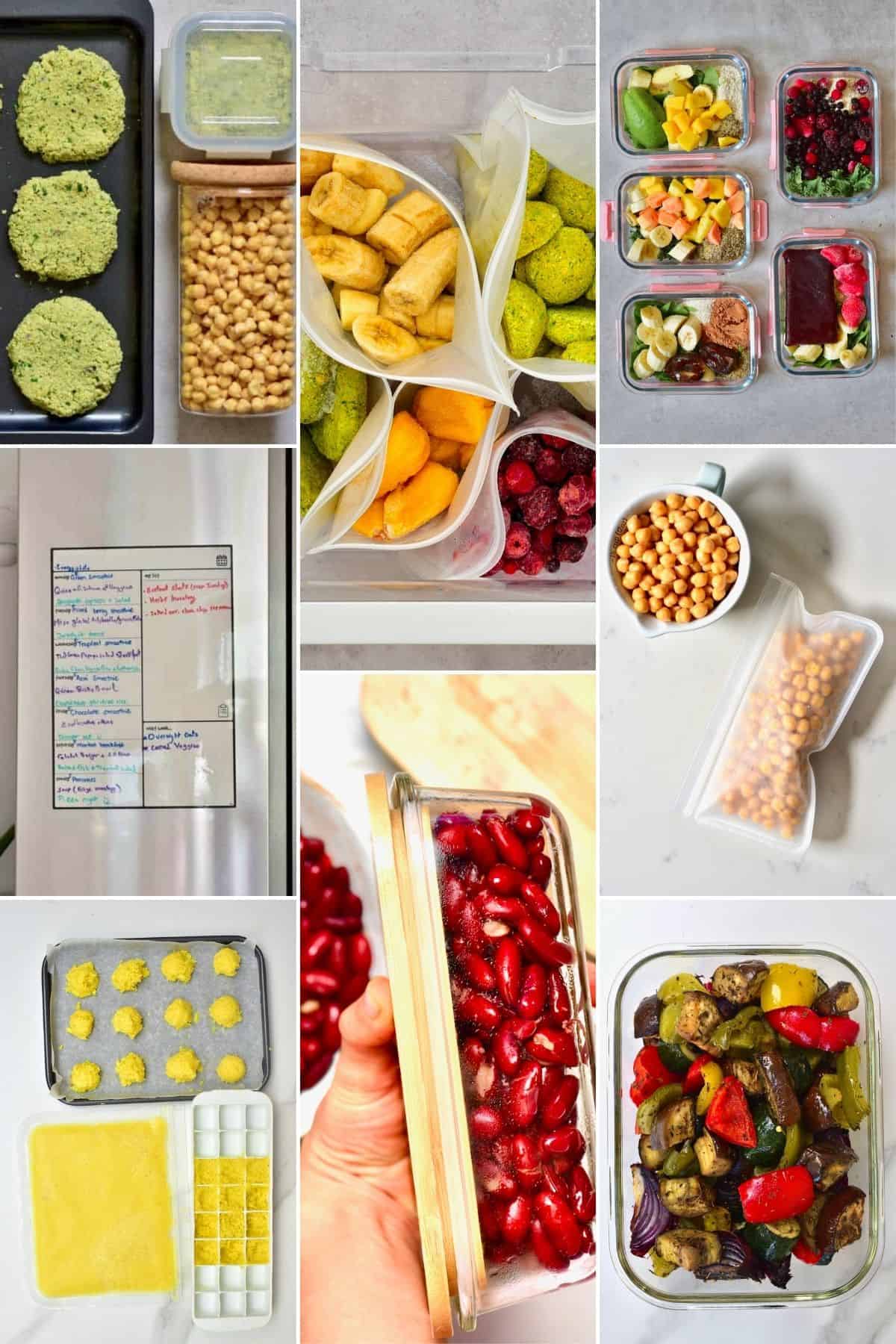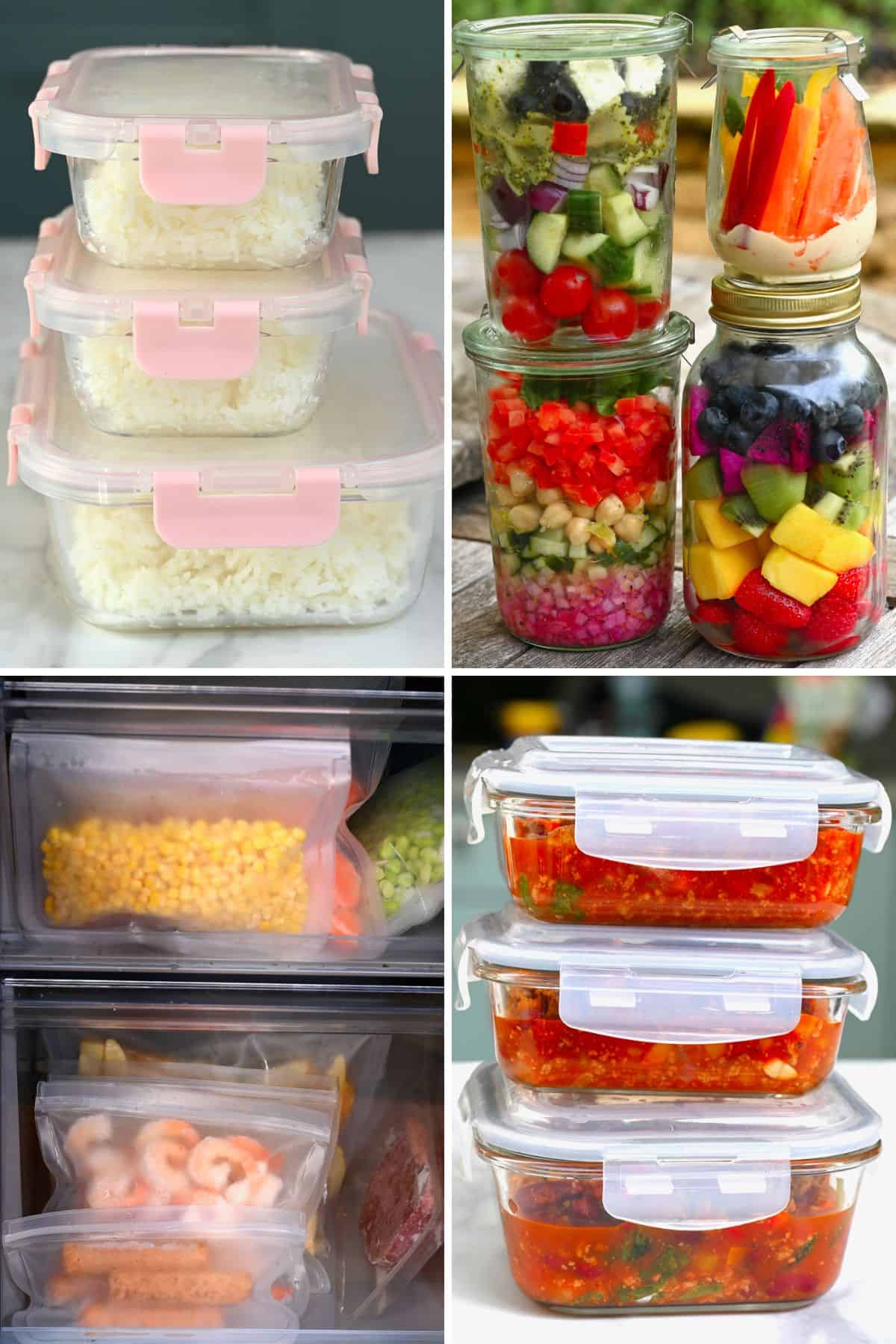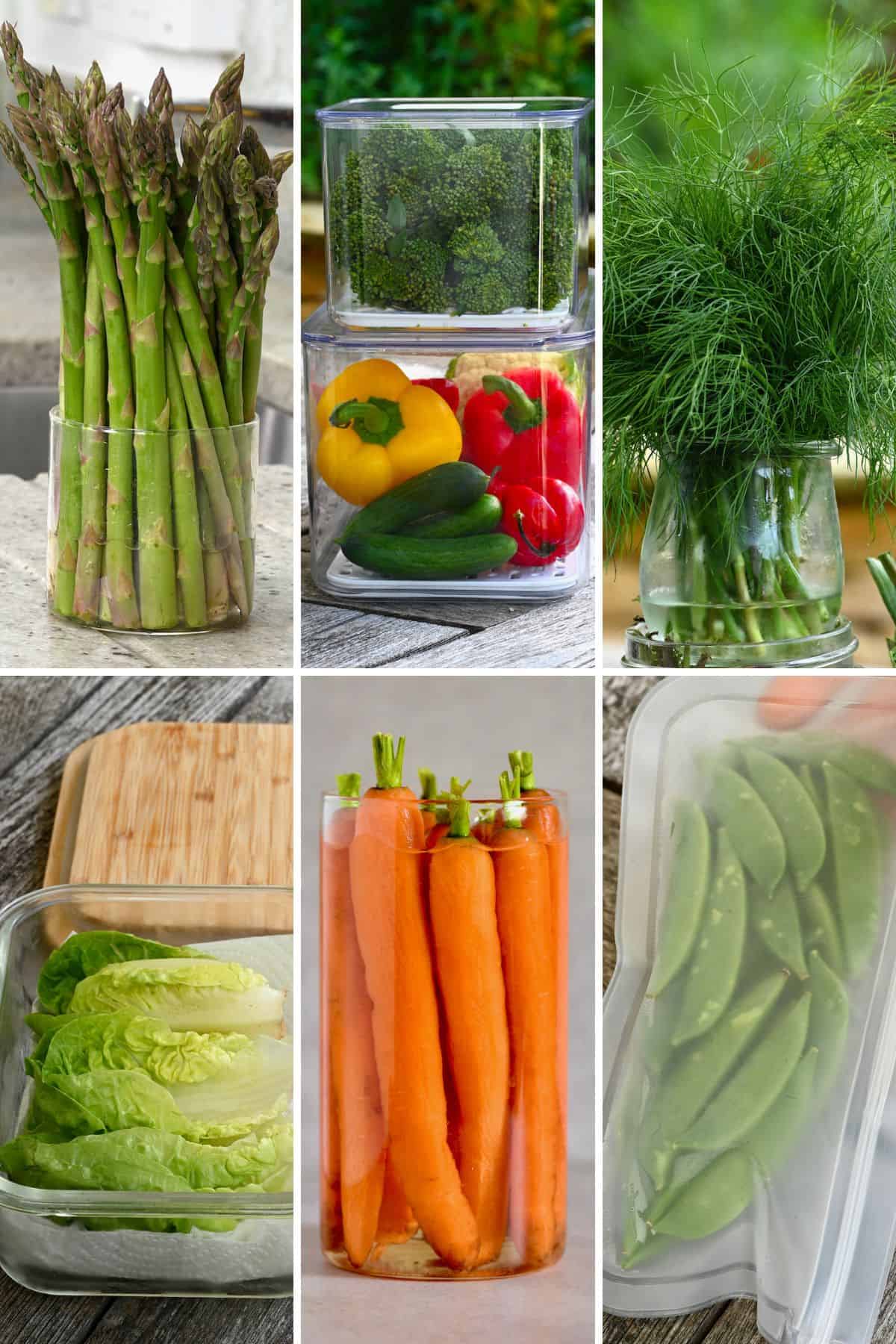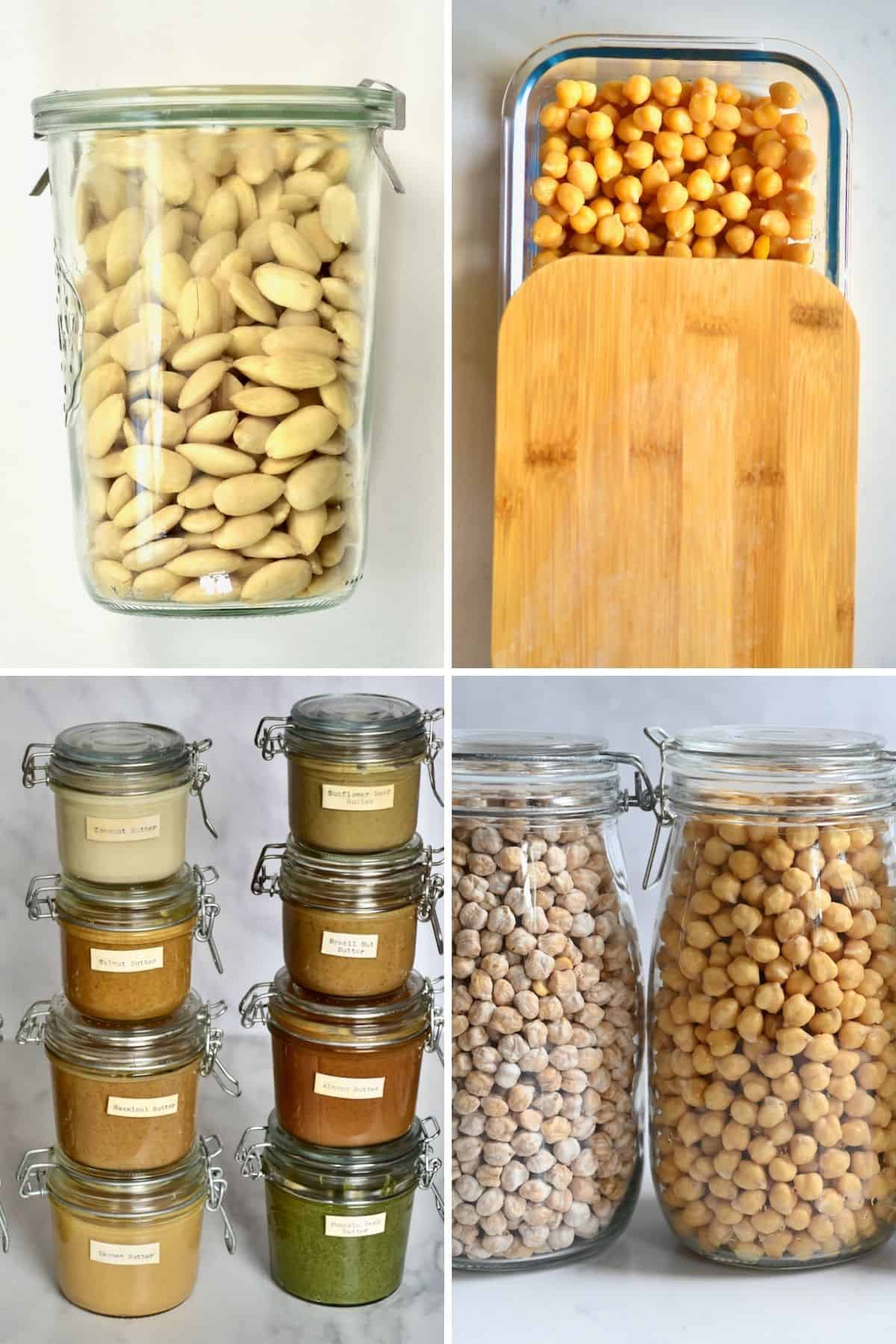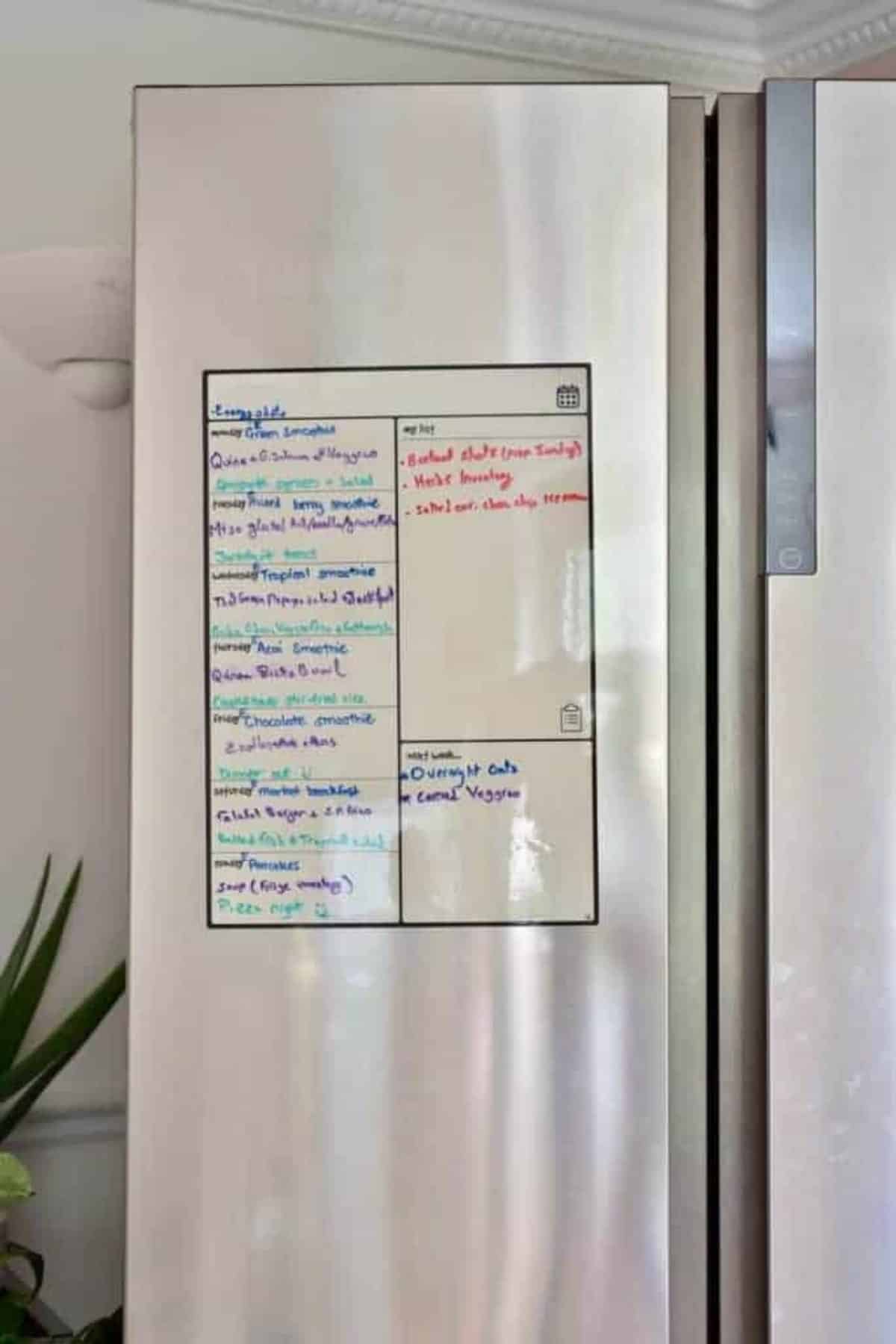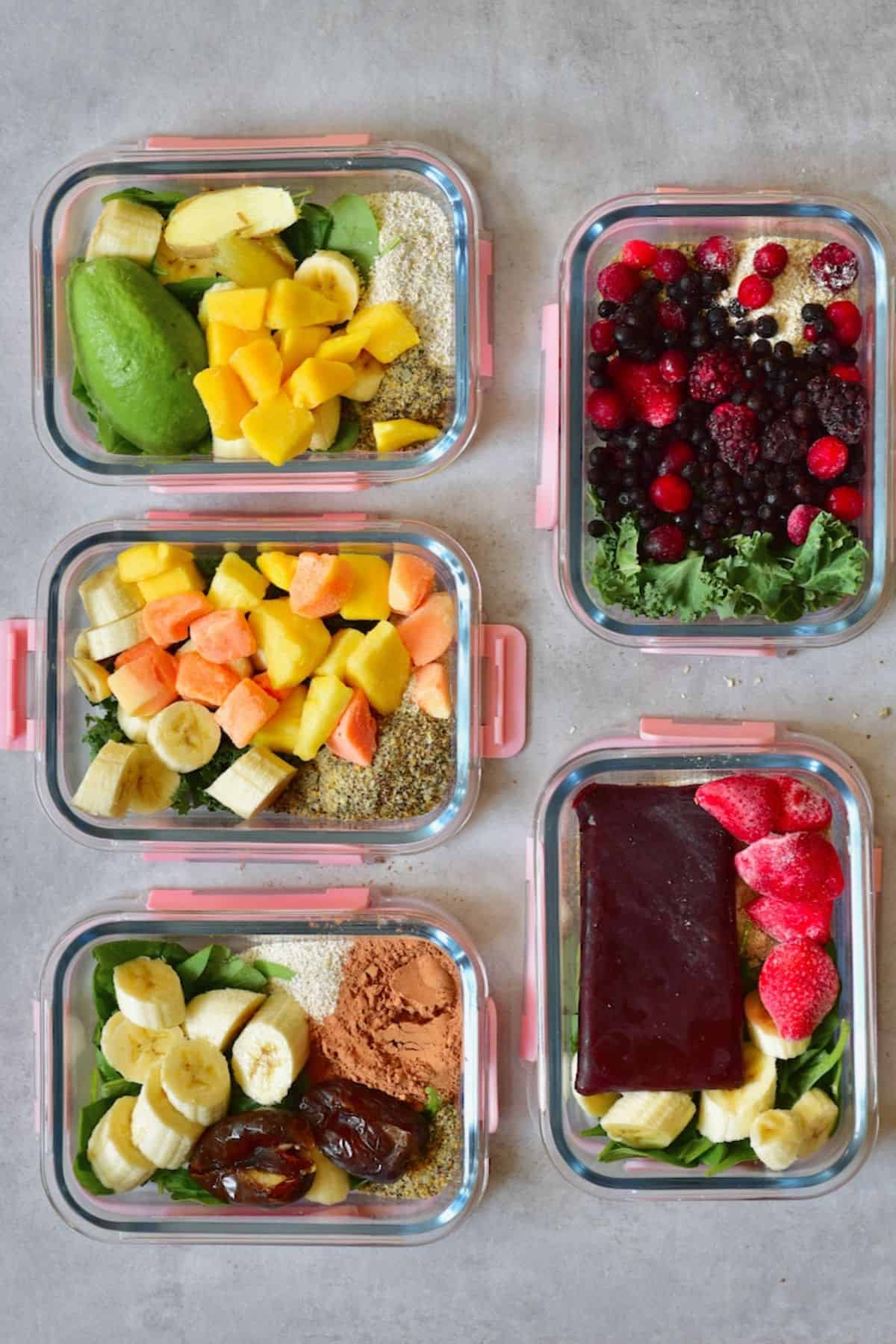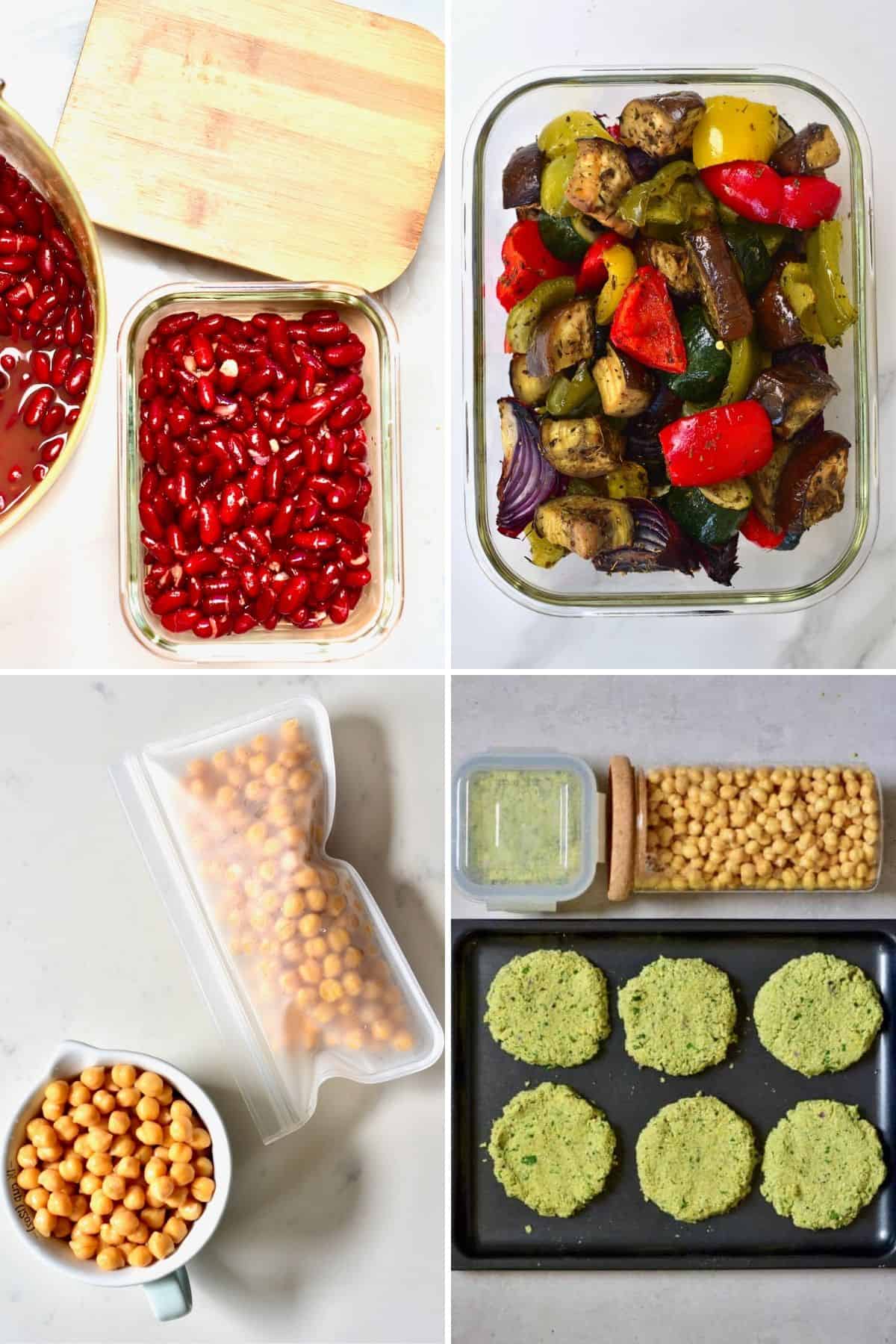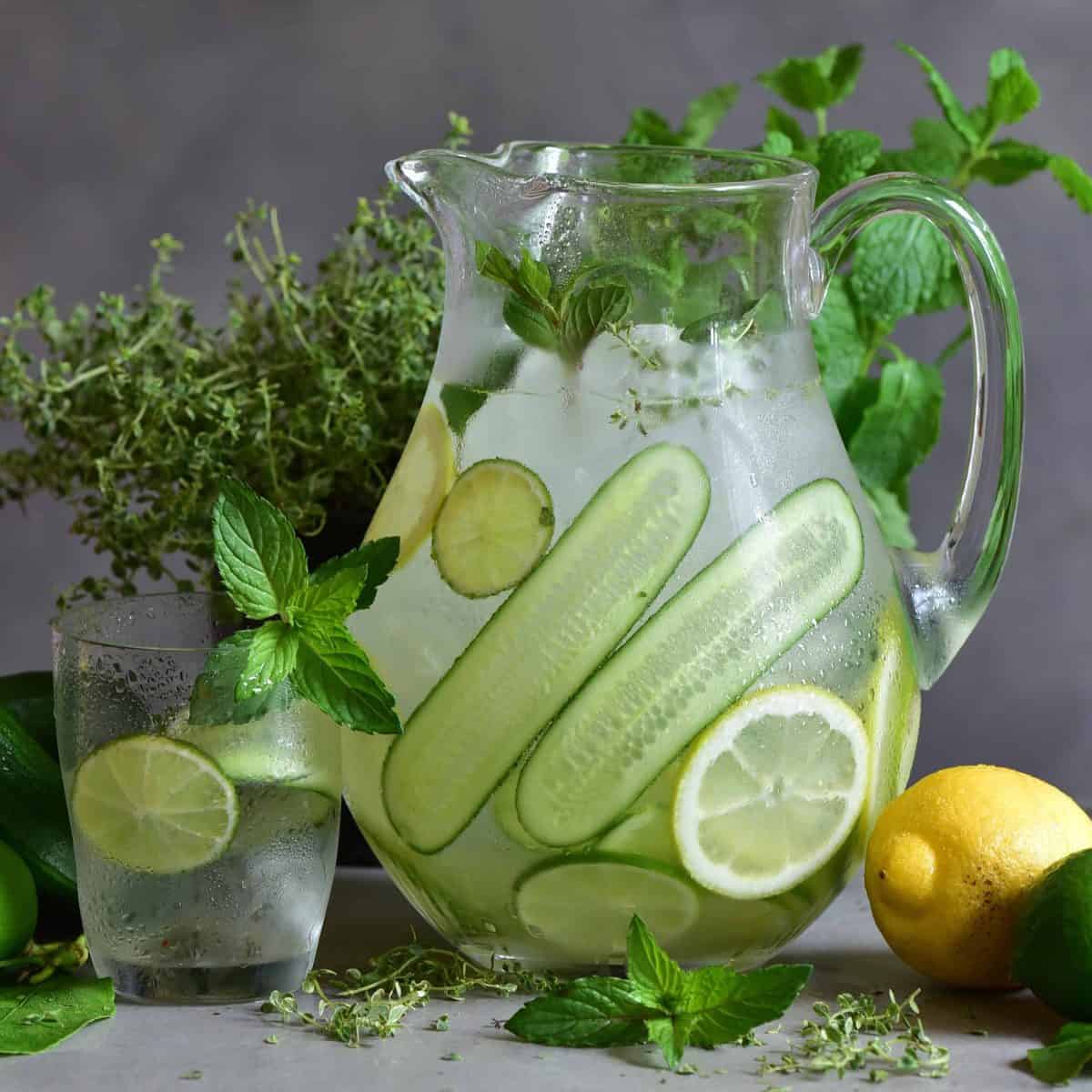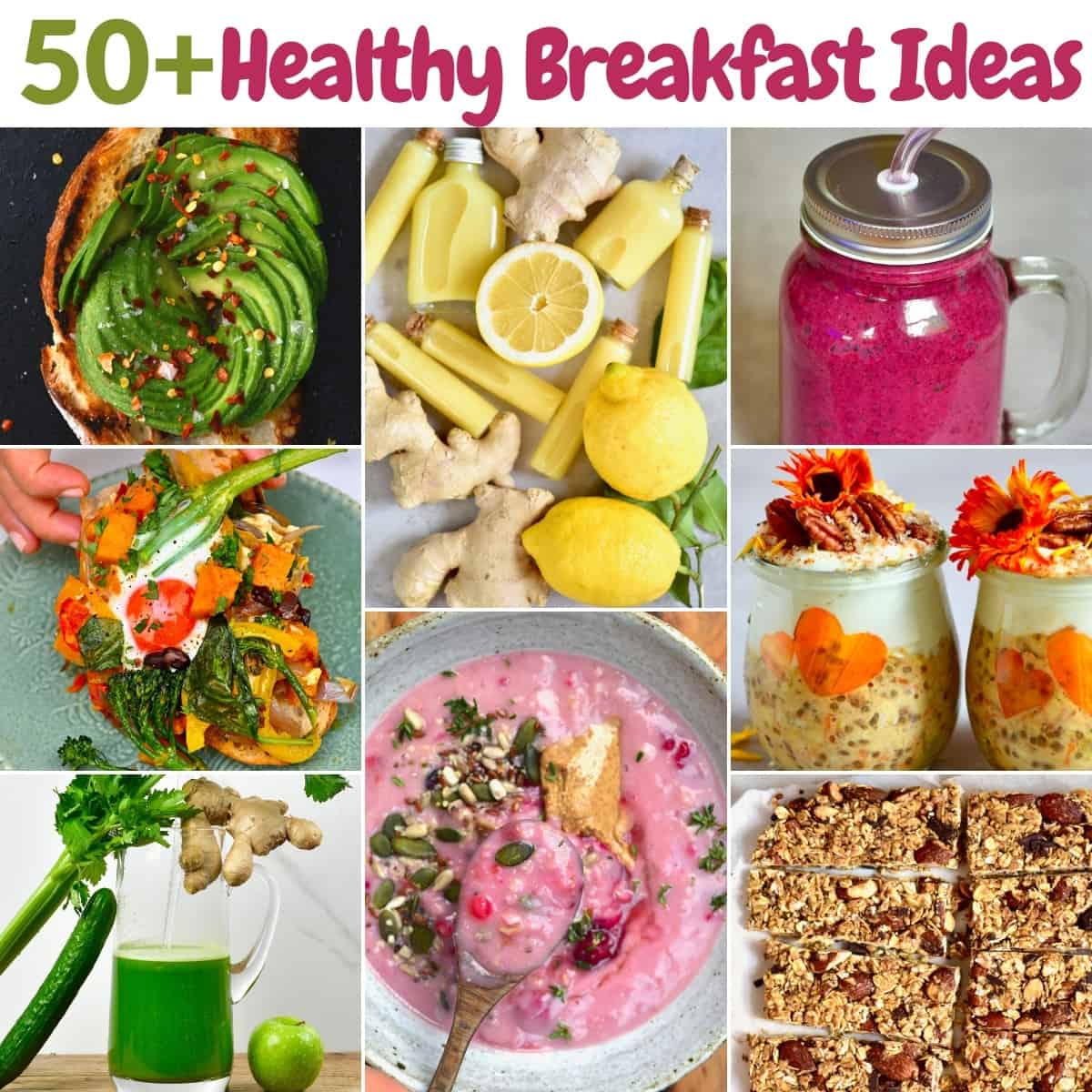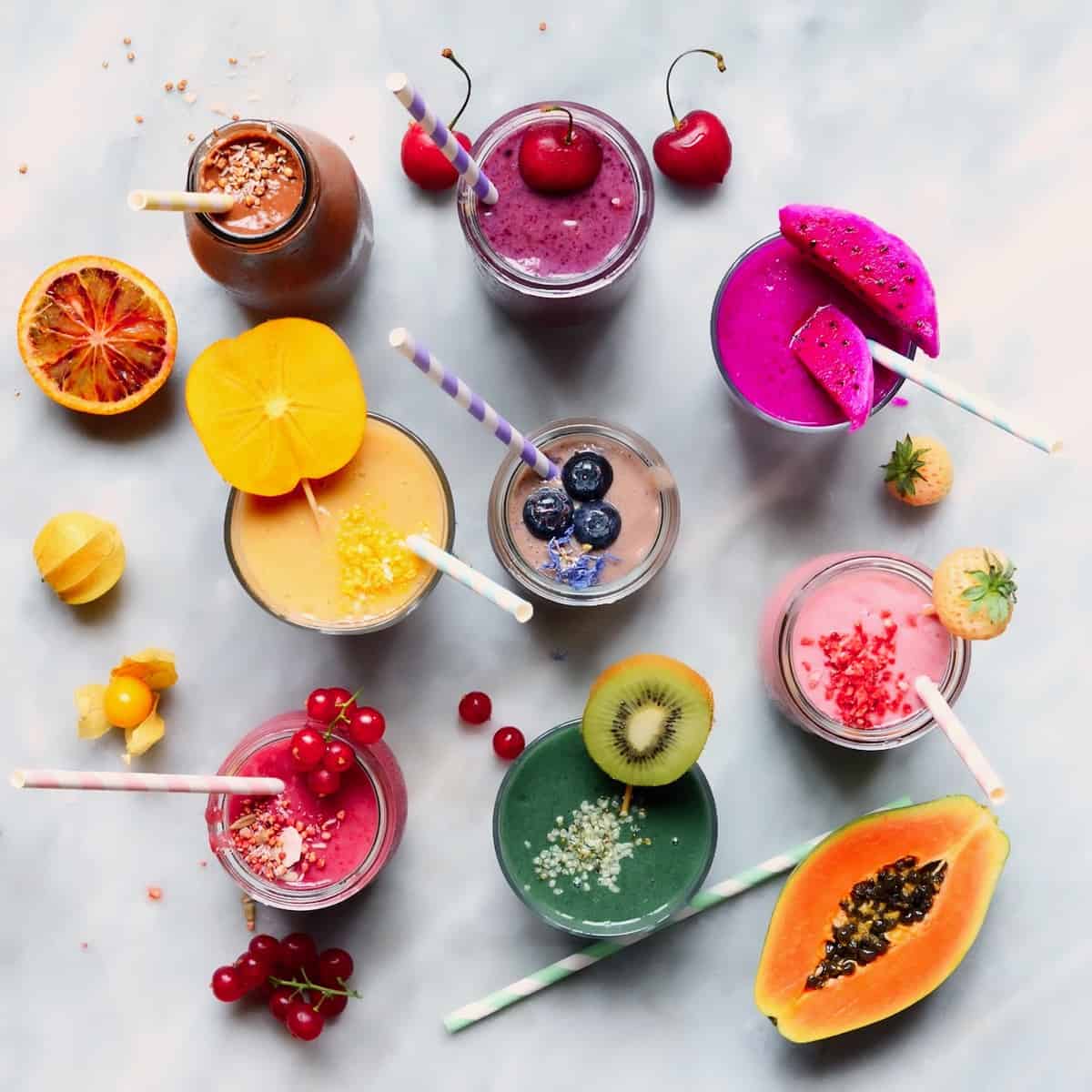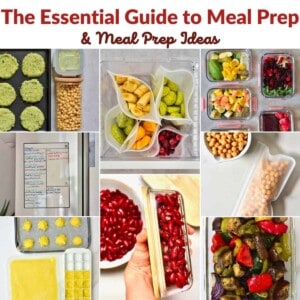Meal prepping can be fantastic for saving time, reducing effort, and helping keep you on track with your dietary goals, especially for those living busy lifestyles and who don’t have the time to spend 20+ minutes in the kitchen every lunch/dinner time. However, meal prep can seem overwhelming and many beginners don’t know how to start meal prepping properly. Within this post, I’ve compiled all my top tips for meal prepping and meal planning. As well as some beginner meal-prep recipes. Think of it as the ultimate beginner’s guide to meal prepping!
What is Meal Prepping?
Unsurprisingly, meal prepping is exactly what it sounds like: preparing meals in advance. However, there’s more to it than that. There’s the recipe gathering, meal planning, shopping list writing, and actual time spent prepping in the kitchen. For meal prep, there are FOUR main types:
Batch cooking: preparing big batches of meals (and ingredients like grains, cooked veg, beans) to store in the fridge and freezer. Best for a large group of people or creating tons of portions in one go. Fridge meal-prep: making entire compiled meals/snacks to store in the fridge over several days (usually 5), often for 1-2 people. Assemble ahead (for the freezer): aka preparing “freezer meals”. Prepare all the elements (chopped veggies, sauce, protein, etc). Then place them in a bag to freeze. Upon thawing, cooking the meal requires no ingredient prep. Ingredient prep: for example, washing and chopping vegetables once a week and other individually prepared components to cut down on food prep later in the week (rather than creating entire meals).
Benefits of Meal Prep
Saving time: get multiple meals/snacks prepped in just 2-3 hours, rather than spending 20-30+ minutes in the kitchen each time you want a meal. Time-saving methods are a must-try for any busy person! Saving money: with your meals planned, you won’t buy unnecessary ingredients in your weekly shop (that may go to waste). More so, you can avoid buying meals out and last-minute takeouts. Stress reduction: spend one morning/afternoon prepping, and you don’t have to worry about those meals for the rest of the week. Sticking to dietary goals: if healthy meals are prepped and ready for you to grab, you’re less likely to rely on unhealthier snacking, quick meals (like pizza/chicken nuggets and chips), or takeout. Over time you may even find yourself having established new healthy eating habits.
The Meal Prep Formula
When meal prepping, whether you stick to a recipe or pick and choose different foods on the goal, it’s great to use a meal prep formula. In this way, with each meal, you are sure to consume varied food with plentiful nutrients. Here is what to include in different types of diets:
Normal Diet Vegetables: Pick your favorites from those that can be quickly roasted or sautées. Asparagus, broccoli, beans, carrots, etc. It’s also great to add some leafy greens. Protein: Pick your favorite protein – choose plant-based (beans, chickpeas, tofu/tempeh), meat, poultry (chicken, turkey), fish, and seafood. Starch: Choose from rice, pasta, potatoes (regular or sweet), quinoa, bread or tortillas, etc. Where necessary choose between white, whole grain, multi-grain, etc. Low-Carb Diet Vegetables: Choose your favorites (see above). Protein: Pick your favorite protein (see above). Vegetarian Diet Vegetables: Choose a selection of your favorite veggies (see above). For extra protein, add beans, chickpeas, or tofu/tempeh. Starch: Pick a start to accompany the veggies (see choices above). For any diet, add a small amount of healthy fats. Add some nuts, seeds, avocado, olive oil, coconut oil, seed/nut butters, etc).
If wanting to portion control, go ahead and measure the elements in advance. An easy ratio to remember is: 1/3-1/2 of your meal is vegetables, 1/4 is protein, 1/4 is starch, and 1-2 Tbsp is healthy fats. Still, being so precise is not necessary for balanced meal prep, so you can simply adjust the quantities to whatever suits you best.
Vegetables That Work Well for Meal Prep
I find that preparing vegetables when cooking is the most time-consuming part. You have to wash them, peel or deseed them, chop them, etc. So it’s a great time-saver during the week to have prepped veggies. Plus, if you are looking for healthy meal planning ideas, veggies should be on top of your list. Vegetables that are perfect for meal prep are those that hold up well. They are harder vegetables that won’t quickly go off or become watery when chopped. You can keep them raw or cook them before storing them in the fridge. You can also meal prep softer veggies but make sure to consume them within 2 days.
Avocado Cucumbers Mushrooms Potatoes Tomatoes
In any case, the fresher the produce, the longer it would last. And any prepared or chopped veggies are best stored in airtight containers to maintain freshness.
Foods That Do Not Work for Meal Prep
As great as meal prep is in general, there are some foods that just don’t work when made in advance. These are usually meals that are best consumed immediately. Not great for meal prep are:
Fruits that oxidize quickly – like apples or avocado, so avoid slicing or chopping them in advance. Soft fruit and veggies – like berries, chopped fruit, etc. Dressed salads – it’s ok to store the chopped salad veggies and the dressing separately though. But a dressed salad is best consumed quickly to avoid it getting watery and mushy. Fresh seafood/shellfish – most of the time, these should be eaten immediately after being cooked so they are not great for meal prep. Foods that don’t reheat well – These foods would lose their texture, change their consistency or become rubbery or too hard or too dry when reheated (like scrambled eggs, white fish, dishes with cream-based sauces, etc.).
Meal Prep Containers You Need
Use good-quality storage containers. There are a few necessities I look for in meal prep containers. They must be:
BPA-free, Microwave-safe, Freezer-safe, Reusable and (ideally) dishwasher safe. Airtight/leak-proof (important for food safety, so avoid using those containers with the wonky, ill-fitting lids for this – we all have some), Stackable is obviously also important.
I prefer to use glass containers over plastic, as I don’t often carry my meal on the go. However, use a more lightweight option if needed. Just make sure to have a good variety of sizes (enough to fit all the portions needed per week). Plus some reusable silicone bags (for snacks). Mason jars are also great for salad/noodle/soups, etc.
How to Meal Prep for the Week
There are two main stages to meal prep: meal planning (creating your meal plan, grocery list, etc.) and meal preparation (in the kitchen). For both, you’ll find that PLANNING IS KEY.
1) Create a Meal Plan
Set aside 30 minutes per week for preparing a meal plan. Use Pinterest/an Excel spreadsheet/hand-written lists to make a note of recipes you like the sound of as you come across them. That way, you already have a selection to choose from when it comes time to plan. Once you are used to meal planning and have tried-and-tested favorites, you return to weekly. This task can take as little as 10 minutes! Plan a basic outline: When selecting recipes, it can help create a rough guide for when you might eat each meal (i.e., Monday – chia pudding, salad, pasta; Tuesday – overnight oats, another salad, etc.). You don’t necessarily have to stick to the plan, but it can make the planning easier, especially for those who don’t want to repeat meals on consecutive days. Don’t plan for too many recipes: Just because you’re meal-prepping for five days doesn’t mean you need 5+ recipes for lunch/dinner meal-prep ideas. Instead, choose 1-3 and make enough of each to spread over several days. If you don’t like eating the same meal two days in a row, don’t. Enjoy one portion on Monday and one on Wednesday, etc. Draw up a cooking plan: I like to approach meal prep a bit like Christmas/ Thanksgiving dinner. First, write out all the recipes you plan to make alongside each of the elements that need prepping, along with their cooking times and methods (stovetop, oven, air fryer, etc.). That way, you can create an outline of the day to be at maximum efficiency and make the most of the time in the kitchen without unnecessarily prolonging it. Avoid recipes that ALL require stovetop or oven cooking (so you end up not having the space to do it all at once). Multi-tasking is your friend! While things bake in the oven, get stuff chopped and prepped. Double up on things by placing a few eggs to boil in with other ingredients, etc.
2) Create a Pantry/Freezer Inventory
This is great for everyone, not only those who want to make budget-friendly meal prep/easy meal planning. Before your first week of meal prep, make a list of all the pantry basics you have and get a general idea of what’s in your freezer, including their use-by dates. That way, you can plan around what needs to be used and avoid having to buy new ingredients unnecessarily or wasting food.
3) Make a Shopping List
Once you have the plan written up, you need to make a shopping list of every ingredient needed (or use one of several apps that allow you to meal plan with ease). Then, cross-reference that with what you have at home. Finally, write up your final shopping list (don’t forget to include your weekly staples). When writing your shopping list, try to do it in order of department from when you walk in the door. For me, that’s usually fresh produce, then fridges, then freezer, then pantry – but the layout of each grocery store can differ. That way, the trip is quick and efficient. I recommend you save the lists over time, if possible doing so in a spreadsheet. That way it’ll make future lists easier to pull together. It’s a good idea to also keep a running grocery list you can add to any time you notice something running out during the week for general topping up.
4) Prepare the Ingredients
You can choose to prepare fully put-together meals or create a buffet-style “pick and mix” range of elements. Still, most (if not all) of those ingredients need to be prepared in advance.
Fruit and vegetables – start by washing and then drying them thoroughly. You can also chop or slice some of the veggies before you store them in air-tight containers. Starches – you can cook them in advance. Then let them cool down before storing them in the fridge in an airtight container. Proteins – prep and cook your protein of choice. Let it cool down and then keep it in an air-tight container in the fridge.
When you prep meals, once cooked, you can store the different elements together (e.g. your starches and your protein). You can also label your meal prep containers with either eat by date or eat on such and such day.
The Meal Prep
Start off small: If you go all out on your first week of meal prep (creating an entire week’s worth of meals and snacks), you’ll be in the kitchen the entire day. Instead, I recommend one of two approaches. First, you can experiment with first prepping just one meal (i.e., breakfast only) and increasing over time. Alternatively, when prepping for several days, use only 1-2 new recipes per week alongside tried-and-tested favorites. That will help with compiling your shopping list quicker and cutting down on actual prep time, too. Make the most of ingredient versatility: Prep elements that are versatile. Repurposing ingredients is one of the best ways to avoid getting bored with your meal prep. For example, the same protein, grain, and/or veggies (like boiled eggs, roasted veggies, cooked legumes, and cooked proteins) could be used in several recipes across the week in entirely new ways (in a salad, as a wrap, in tacos, in omelets/frittata, in soups). Choose basic meal prep recipes: When you’re making enough food to get you through 5 (or even 7 in some cases) days, the last thing you want to be doing is struggling your way through tons of complicated steps while juggling several recipes. Keep an eye on nutrition: If you’re meal-prepping with health/fitness in mind or are learning how to meal prep for weight loss, then choose meals and snacks that will complement each other nutritionally. For basic meal prep, you’ll need to consider eating enough protein, carbs (pasta, grains, bread), healthy fats (nuts/seeds, avocado, olive oil, etc.), and plenty of fresh fruit/veggies. Set aside the time to prep: It’s easiest to set aside a specific prep day each week (many people choose Sunday). Make sure you have set aside several hours (especially at the beginning, as it can take longer while you get used to it). Finally, try to stick to a meal prep schedule. Obviously, life can get in the way. But sticking to a general schedule will help streamline easy meal prep. I share below some of my top easy meal prep recipes, including quick lunch ideas, so keep on reading!
How to Meal Prep Chicken
Chicken is a great lean protein that’s a great option for meal prepping. It’s best to cook the whole breasts without cutting them in advance. One way to do that is to simply sear the chicken in a skillet with a bit of oil or butter, just season to taste. Another option is to marinate the chicken before cooking it. Then, every week, you can switch the marinade and season it differently. You will get flavorful, tender, and juicy chicken week after week. Once cooked, you can chop the chicken into smaller pieces and store it alone or with pre-cooked grains or veggies in air-tight containers. Keep it in the fridge for up to 7 days or freeze it for up to 3 months. You can then make a chicken salad, or enjoy some chicken and rice, etc.
How to Meal Prep the Basics
You can prepare big batches of ingredients like legumes, grains, vegetables, sauces, etc. Once cooked, some of them can also be frozen to extend their shelf-life. Some of my favorite basics that I cook in advance are:
Dried red kidney beans/Dried chickpeas, Cooked brown rice, Fluffy jasmine rice, etc.), Quinoa, Roasted vegetables like roasted vegetable salad with grains. Sauces and curries (like Bolognese sauce, pasta sauce, mushroom ragu, etc.), Vegetable stock (for soups and stews), etc.
Simply cook a big batch, then portion it and keep it in the fridge or freezer. To cool them down quickly (so you can store them away faster), you can spread them on a sheet pan. This will help the heat dissipate. Then portion them in your boxes.
Overnight Oats
Hot Lunch Ideas
When I know I will be at home for lunch (or I will be able to reheat my meal), I love taking with me some proteins and grains that I can reheat and enjoy warm. These meal prep lunch ideas are great, especially on a cold winter day. I love mixing some rice or quinoa with a protein like crispy tofu, teriyaki salmon, chicken shish tawook, etc. Also, check my 30 Hot Lunch Ideas (Fast, Meal Prep, Easy Recipes)!
Cold Healthy Meals & Side Dishes
Salads are one of my favorite healthy meal prep ideas. They are great on their own or as a side to other mains. Some of those that are great for meal prep are quinoa salad, beet and carrot salad, broccoli salad, etc. You can also add salad to sandwiches for quick lunch meals.
Soups
I love soups and make them all the time – winter or summer. What’s great about them is that you can also freeze them. These creamy soups are perfect for making in advance: broccoli cheddar soup, roasted cauliflower soup, carrot ginger soup.
Lunch Wraps & Tortillas
Whether you want vegan wraps, low-carb wraps, or healthy wraps – there is a way to utilize the tortilla wrap hack. By making simple ingredient swaps you can create whatever you want in minutes! Choose 2-4 different fillings for your wrap. These can be any of your prepped ingredients – chopped veggies, dips, sauces, cooked protein, etc. Check my post for 20+ delicious wrap fillings for more lunch prep ideas.
Dips
Dips and crudites (like chopped carrots, peppers, celery, etc) are a great snack or side to prepped meals. And you can prepare them in advance. Some of my favorites are best hummus, easy baba ganoush, garlic white bean dip, etc.
Shortcuts and Tips
Fridge organization chart: Add a magnetic whiteboard or list on the fridge where you’ll note the products that have run out and any ideas of items you might need to buy to get you through the week. Embrace the slow cooker or instant pot: not only is it ultimate hands-off cooking, but it can be prepared, so it’s ready for lunch/dinner. Make your first meal-prep meal of the week in it. You can eat the meal “fresh,” instead of as leftovers. Make the most of your kitchen tools: air fryers are great for speeding up cooking times. Meanwhile, slow cookers allow you to create meals almost entirely hands-off. Don’t be afraid of frozen ingredients: they are often fresher, last longer, and are even less expensive than their “fresh” counterparts. Likewise, you could even stock up on frozen grains to cut down on meal prep time. Keep herbs/spices stored: these can go a long way to turning a meal from blah to “oh yah,” so make sure you always have plenty in store!
How Do You Reheat Lunch Meals
When reheating lunch meals, it’s best to warm them up till piping hot. In this way, you ensure even heating. When using the microwave, make sure to stir the food halfway through cooking. If using a pan, flip and stir a few times. If you don’t have access to a stovetop or microwave, you can reheat your food with boiling water. Place the food in a stainless steel bowl or another heat-proof container, close the container and place it in a larger bowl. Then pour boiling water over it. The food should warm up within 5-10 minutes.
More Helpful Guides
Guide to Fridge Organization, Ideas and Tips Flavored Water Recipes 50+ Healthy Vegetarian Breakfast Ideas Guide to Healthy Smoothie Recipes 20+ Winter Soup Recipes – Easy, Delicious, Comforting 40+ Delicious Summer Drink Recipes 20+ Best Breakfast Sandwiches January Produce and Recipes February Produce and Recipes
I’m thinking of pulling together several meal-prep posts based on specific meal times (how to food prep for breakfast, lunch, dinner, snacks), etc. Let me know in the comments if that’s something you’d be interested in. If you enjoyed this guide on how to meal prep for beginners, I’d love to hear your thoughts/questions below. Also, I’d appreciate a recipe card rating below, and feel free to tag me in your recipe recreations on Instagram @Alphafoodie!
